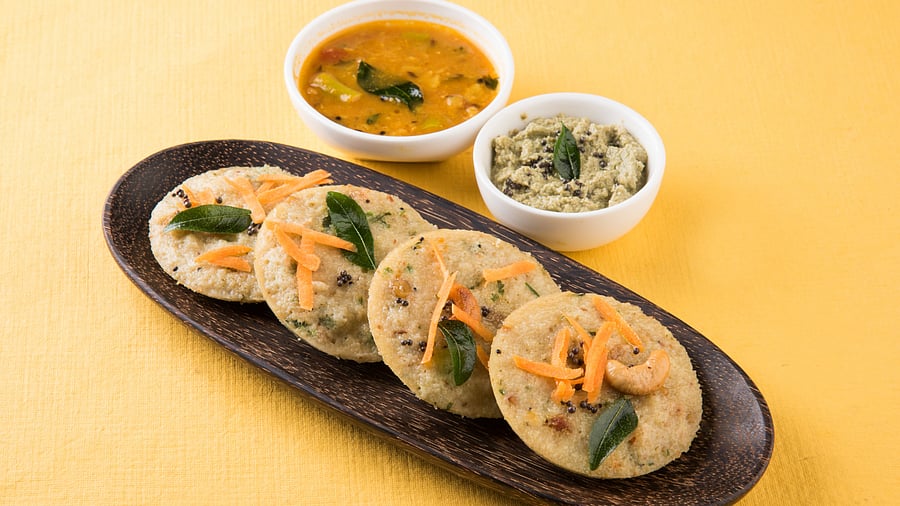
Image for representation.
Credit: iStock Photo
Few things evoke the grandeur of culinary traditions as powerfully as dishes crafted with semolina. Recently, as I savoured a plate of soft, round Ledikeni sweet balls — fried to a perfect golden brown — at the iconic Mishti Hub in New Town, Kolkata, I realised that the tradition of cooking with semolina continues to thrive.
In fact, my reflections on semolina were further enriched by a friendly, middle-aged staff member at the heritage sweet shop, who shared an intriguing historical titbit. He took me back in time to the British Raj, when the Ledikeni sweet was created to honour Lady Canning, wife of Governor General Charles Canning. He explained, “even today, while making the traditional round or oblong Ledikeni, we add suji (semolina) to the chhena (crumbled paneer), sugar, and ghee dough. The semolina helps create a smooth texture in the dough, which is then fried to a perfect golden brown.”
This was not the only instance where semolina’s role in preserving culinary tradition stood out. During Janmashtami last year, I had the chance to experience Mohan Bhog, Lord Krishna’s favourite dish, at the Swami Narayan Mandir near IIM Joka, Kolkata. The temple kitchen had carefully preserved the tradition of preparing this thick, cardamom-infused halwa by slow-simmering ghee-roasted semolina in milk over a gentle flame, until it thickened into a creamy, aromatic mixture. The halwa was then garnished with slivered cashews and served with luchis (deep-fried flatbreads), embodying the divine flavours of the past.
It’s not just the Ledikeni or the sacred Mohan Bhog — semolina-based dishes continue to enjoy popularity across India. Take, for example, the rose-scented Falooda, a dessert popular since the Mughal era. The Falooda is traditionally made with thin strands of semolina vermicelli (seviyan) rather than rice vermicelli. According to historical accounts, in the 16th century, Persian cooks introduced Falooda to northern India, where the royal kitchens of the Mughals replaced rice vermicelli with seviyan, creating a smoother, more delicate texture. Even today, a heritage sweet shop near Delhi’s Red Fort continues this tradition by boiling the seviyan until silky-soft, then assembling the dessert with basil seeds, rose syrup, cold milk, and a scoop of ice cream.
Semolina’s legacy also extends to baked treats, such as Goa’s famous Baath cake. This semolina and coconut cake, flavoured with almond essence, is a local adaptation of the Moorish basbousa, which originated in the Middle East. The Moors brought basbousa to Portugal, where it was refined by using fine semolina, creating a smoother, moister cake. Upon the arrival of the Portuguese in Goa in the 15th century, this cake evolved into the Baath cake, retaining the use of fine semolina and ground almonds. Today, the Goan Baath cake remains a festive favourite, prepared by mixing roasted semolina with coconut, coconut milk, sugar, and baking powder, then baking until golden brown. As tradition dictates, it’s finished with a drizzle of Portuguese almond essence and garnished with cashews.
In fact, the ‘Halwa ceremony,’ is a traditional event marking the commencement of the Union Budget’s compilation and printing process. It features the Finance Minister stirring halwa in a kadhai, symbolising the start of the Budget preparation. Last year, this ceremony happened on Republic Day.
Semolina is also a key ingredient in savoury dishes, like the South Indian upma. This breakfast staple has been a beloved part of southern cuisine since the late 18th century. The dry-roasted semolina is sautéed with a medley of lentils, mustard seeds, curry leaves, and vegetables such as carrots, beans, and peas. The result is a fragrant, savoury dish enjoyed throughout the southern states.
The tradition of cooking with semolina extends far beyond India. In Russia, the Guryevskaya Kasha — a rich, creamy porridge once enjoyed by the Tsars — features semolina simmered in sweetened milk, and baked into a comforting dish.
Similarly, in Sicily, fine semolina has always been a fundamental ingredient in the region’s crusty, pale yellow Pane Siciliano bread.
From Kolkata to Russia to Sicily, semolina remains an essential ingredient in traditional cuisines worldwide. It’s a testament to how culinary traditions evolve, yet endure, weaving a rich, flavourful history that continues to be celebrated today.